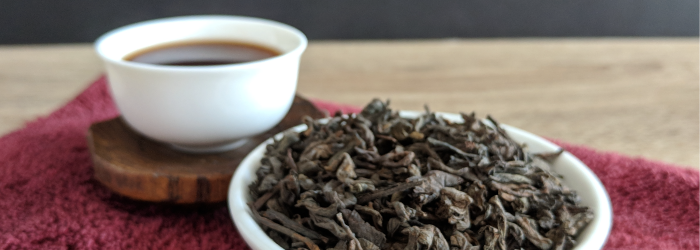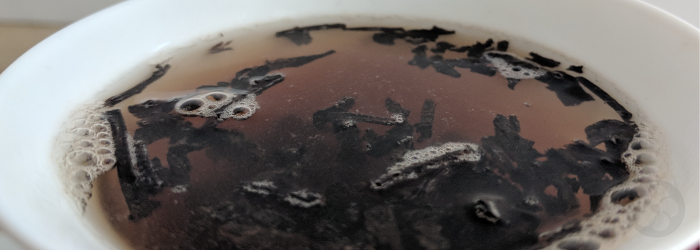6 Reasons to Drink Pu-erh Tea

Distinct from any other tea style, the aged, fermented teas from Yunnan Province known as pu-erh remain somewhat mysterious in the western world. The style we know today was developed relatively recently (in the context of tea’s long history) and didn’t reach peak popularity until late in the 20th century - long after modern western traditions had diverged from their Chinese roots.
What is Pu-erh? Let Alice introduce you to this unique style in this video:
Perhaps this late introduction offers some explanation for the common confusion over the basics about this type of tea, like variations between spellings like puer, puerh, and pu’er. But today, this style is rapidly growing in popularity, both within China and around the world. Well-aged pu-erhs now rank among the most valuable teas in the world, and fresh batches of high quality maocha (unfinished tea) are considered long-term investments by practiced collectors.
Learn more about what maocha is >>
Unfortunately, much of the available information about pu-erh is confusing or contradictory, and rather incomplete. Many sources are dry and one-sided, describing pu-erh as if it were a medicine rather than a tea to be enjoyed.
This is a shame, as pu-erh as a category is especially captivating for a multitude of reasons, not limited to health benefits. Here are six reasons we think pu-erh tea is worth drinking, whether as a daily brew or a special treat.
1. Fermentation creates a unique flavor profile.
Despite the dark color of pu-erh tea, flavors in this category differ dramatically from other dark styles, like black tea. This is because while black teas leaves darken through an enzymatic reaction called oxidation, pu-erh becomes dark through a process of microbial fermentation.
Learn about the difference between oxidation and fermentation >>
Rather than being bruised, allowed to oxidize, and then roasted to remove all moisture, pu-erh teas are given a light roast before being heaped or compressed to produce microbial activity within the leaves. Over time, this process fundamentally changes the molecular compounds within the leaf, transforming the flavor profile into something unlike any other style of tea.
The result is generally called ‘earthy’, but the flavor variation within this single category can hardly be pinned down in a single word. Woody mushroom, sweet hay, and herbal flavor notes like camphor and aloe are all commonly found in pu-erh teas.
Differences in storage conditions, like temperature and humidity, can produce even more diverse layers of flavor. Many pu-erhs are described as having notes of scotch, with nuances of woodsmoke and leather; notes of sweetness, reminiscent of dried cherries and stone fruit, or even creamy and bright flavor profiles that defy expectations. A single harvest, separated for aging in contrasting environments, can develop wholly distinct flavor characteristics.
In that sense, pu-erh flavor reflects not only the variety, provenance, harvest date, and craftsmanship, but also the individual history of each batch’s aging process. This creates the potential for vast flavor variety, and is one of the most exciting aspects of drinking pu-erh teas.
2. Low levels of tannins make it easy to brew without bitterness.
As the process of fermentation creates these unique flavor profiles, it also breaks down naturally bitter compounds within the leaf. These molecules, generalized into a category called ‘tannins’, typically lend bitterness and astringency to tea, and are particularly common in dark styles like black tea. Generally, these aspects are recognized as a component of ‘strong’ tea flavor.
Learn more about what tannins are in the context of tea >>
Before aging begins, most pu-erh tea leaves have very high levels of tannins. Though these ‘green’ pu-erhs are growing in popularity (as properly aged examples rise in price), they are generally harsh in flavor, requiring a skilled hand to brew without bitterness, and often displaying astringency.
These characteristics can be appreciated by tea connoisseurs who enjoy a long-lasting finish and careful brewing sessions with many infusions, but they are rarely considered ‘easy to drink’. Yet fermentation transforms pu-erh tea into exactly that. As with well-aged wines, tannins soften and fade over time in these teas, leaving flavor that is bold, but lacking any trace of the acidity or dryness that tannins produce in other styles.
Ultimately, this process makes pu-erh extremely easy to brew. These hearty teas can be forgotten in a mug, left in a pot during a long meal, or tossed in a travel thermos without ever becoming vegetal, bitter, or dry.
3. Aging naturally breaks down caffeine molecules.
Within the pu-erh category, there are two primary ways to produce microbial fermentation. While both methods break down tannins and produce dark leaves with rich flavors, there are some distinct differences between these two sub-categories of pu-erh teas. One of the most interesting is the effect on caffeine levels.
Sheng pu-erh is the original style, probably developed by happy accident as tea leaves, compressed into discs or cakes for easy transport over long distances, were left to age in humid conditions. Shou, or ‘cooked’ pu-erh is the newer style, made with an accelerated process of fermentation conceived in the late 20th century as a way to keep up with demand as the category became more popular.
Learn more about the difference between sheng and shou pu-erh teas >>
This distinction is important, because while the accelerated process used to craft shou teas leaves caffeine mostly intact, the aging process that naturally creates sheng teas breaks down caffeine over time. The reasons for this discrepancy are not clear, but studies that test levels of caffeine after fermentation show a definitive decrease in levels with increased age.
Aging does not, however, seem to affect the levels of L-theanine found in tea, meaning that sheng pu-erh teas can still contribute to an overall feeling of focus and calm. This is one reason that a well aged sheng is one of our favorite luxurious treats in the evening.
4. Pu-erh pairs well with food and aids digestion.
The other reason is that pu-erh is the perfect accompaniment to a hearty dinner or rich dessert, with bold flavors that pair perfectly, and microbial activity that helps the body digest heavy fats.
Much like a bold red wine is recommended as a match to rich flavors, the strong, smooth profile of pu-erh is a perfect complement to heavy foods. If you enjoy a choice cut of rare steak, a pu-erh with a touch of camphor in the taste cuts into the fat and elevates the sweetness of the meat. With a slab of dark chocolate, a pu-erh with notes of stonefruit enhances the sweetness with tart notes, and brings out the rich cocoa taste of the chocolate.
While the digestive properties of pu-erh are sometimes grossly exaggerated for marketing as an aid to weight loss, this is one health claim that has some basis in both tradition and science. Studies in rats have shown that pu-erh can help the body process dietary cholesterol, reinforcing the logic behind the tradition of serving pu-erh alongside greasy dim sum. Anecdotally, we know a good cup of pu-erh always helps settle our stomachs after a heavy meal, or even one too many glasses of wine.
5. Compressed leaves are designed for travel.
Whether it’s a sheng after dinner or a shou in the morning for a small kick of caffeine, pu-erh is the perfect, easy brew to have on the go. On our sourcing trips, we always pack along some pu-erh for an easy-to-brew tea fix, and this is made even simpler with traditional compressed ‘cakes’ of tea, which are specifically designed for easy transport.
Learn how to use and shop for tea cakes with Alice in this video:
Pu-erh teas were traditionally pressed into tea cakes for long-distance transport to the plains of Mongolia, where they were an essential part of the protein-heavy nomadic diet. Today, our travels are less arduous, but a small cake of compressed pu-erh leaves is still easy to pack and carry without worrying about crushed leaves or bitter brews. In addition, the bold flavor of pu-erh tea is easy to brew well with water of any quality or temperature.
Learn about the difference between loose leaves and compressed leaves >>
6. Pu-erh teas improve with age.
Most teas go stale after a few years. The lighter the tea, the faster they fade. Pu-erh is the notable exception, with a shelf life that is essentially endless, provided it is stored properly.
The parallels with fine wine are evident: products of tradition and craft, improving with age and becoming more valuable with skilled storage. And many collectors, especially in China, take the aging process just as seriously as a connoisseur of wine might. More than just a hobby, pu-erh tea can be an investment, aged for decades, or even whole lifetimes before it reaches its full potential. A serious collection can even be seen as a valuable inheritance for children or grandchildren.
This trend is just starting to emerge in other places around the world, as well, where pu-erh drinkers often struggle to replicate the environmental conditions of East Asia for maximum flavor development over time, even coining the word ‘pumidor’ for their humidity-controlled boxes modeled after the humidors used for cigars.
Learn more about how storage conditions can affect pu-erh flavor >>
For those tea lovers who are prone to hoarding their favorites, pu-erh can be a rewarding experience. Choosing young teas to purchase and watching their flavor change over time is a skill to be honed. Or, marking anniversaries with a commemorative tea can be a memorable bonding experience.
The unique characteristics of pu-erh teas have given it a cherished place in Chinese tea culture, and more recently, in the west as well. If these reasons pique your interest in exploring this diverse style, we invite you to explore our collection of pu-erh teas, which includes a range of styles, each carefully selected for high quality flavor independently tested to ensure they are free of common agricultural chemicals.
With contributions by Nicki France.
Sign up for our newsletter to get blog updates in your inbox!










Comments on this post (2)
Fabulous, informative, and glowing write up. Gratitude. Time for tea ;)
— Ayden Bremner
Very informative! I’m almost out of tea so I’ll be seeing you soon. I do prefer Oolong but will try some pu-erh next time we meet.
— Cesar